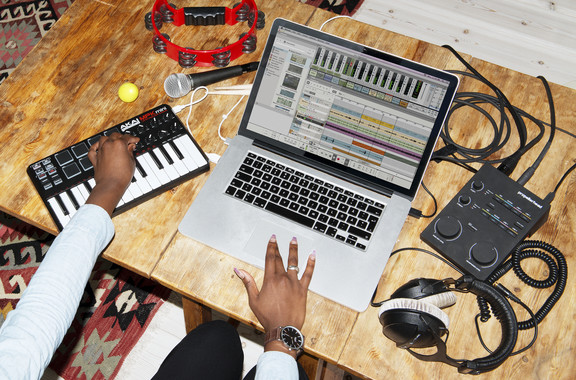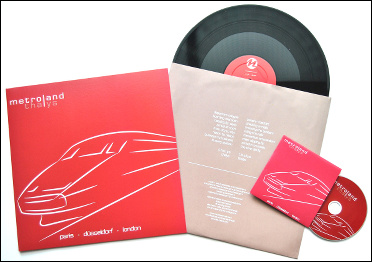Reason 8 is here – all the details
Propellerhead Software has announced the release of Reason 8, a major new version of the award-winning Reason music production software which introduces a completely redesigned user interface and streamlined new workflow.
“Musicians and producers love Reason because it’s both fun and inspiring,” said Leo Nathorst-Böös, Propellerhead Product Marketing Manager. “For Reason 8, we’ve introduced a new creative flow that feels second nature to exploring sounds and developing songs. Whether you have lots of experience or just starting out, Reason is the fastest way to develop musical ideas and capture your inspiration.”
Reason 8 introduces a redesigned user interface, fresh new look and even smoother creative flow. Quickly and easily access your sounds, loops and patches whenever you need them using a new browser and search window—a one-stop-shop for creative inspiration. Dial-in incredible guitar and bass tones with a collection of new amps from legendary circuit modeler Softube—simply plug in your instrument, crank up the volume and experience the uncompromising tone, response and dynamics of the world’s finest classic amplifiers.
Reason 8 also features countless usability improvements that put the flow back in workflow. Drag-and-drop from anywhere to anything and work faster with fewer clicks. Edit your tracks quickly with more powerful sequence note editing. Reason 8 lets you flow seamlessly from initial idea to completed song. And, with an ever-expanding selection of Rack Extension plug-ins available in the Propellerhead shop, you can easily expand your rack to include everything your music needs—now and in the future.
Reason 8 is available for purchase for 405 EUR/$449 USD, Reason Essentials 8 is 120 EUR/$129 USD, and the Reason 8 Upgrade (from any previous Reason version) costs 129 EUR/$129 USD. Propellerhead is also offering a grace period for customers who purchased Reason 7 on or after July 1, 2014
Elektron Analog Four : Tutorial by 7-year-old, creating Photographic by Depeche Mode
A tutorial on how to use the Elektron Analog 4 and using it to program “Photographic” by Depeche Mode – from the perspective of a seven-year-old kid. In Swedish, filmed in one go. English subtitles are available as well.
00:00:00 Introduction, overview of main functions
00:02:17 Sound selection
00:02:20 Track 1 – Lead
00:02:44 Track 2 – Kick
00:03:04 Track 3 – Bass
00:03:20 Track 4 – Secondary melody
00:03:38 Programming “Photographic”
00:03:34 Track 1
00:05:40 Track 2
00:05:59 Track 3
00:07:19 Track 4
00:08:13 Track 4, again
00:09:05 Song complete!
My 7-year old son started to learn my Elekron Analog Four, and actually got pretty good at it. Since he loves “Photographic” by Depeche Mode (and had been playing it on the piano) he taught himself to program it into the A4.
One day I thought I should just capture what he’s doing on video to keep as a memory, and a the same time learn a two-cam setup. This is the result – all filmed in one go. There are English subtitles available in the video as well.
Oskar Novak Moog synthesizer demonstration
Oskar Novak demonstrates his Moog XL and Moog Subphatty synthesizers and plays original compositions utilizing these two amazing instruments. He begins playing at 43 seconds.
Aphex Twin – Fenix Funk [early Mix] UNRELEASED
Aphex Twin – Fenix Funk [early Mix] – unreleased version of the classic Analord track. From the forthcoming exclusive Aphex Twin interview with Dave Noyze at Noyzelab :
noyzelab.blogspot.com/2014/09/aphex-…y-mixdown.html
noyzelab.blogspot.com.au/2014/09/unre…arclays.html
Demonstration of the new EGDR909 – 909 Drum Machine emulation
Apple Store link:https://itunes.apple.com/us/app/egdr9…
ElliottGarage presents EGDR909, a drum machine that emulates the vintage hardware from the 80’s with all the facilities of modern software.
Its realistic and clear interface recalls the analog machine from the past, for all the vintage fanatics.
You can play with the groove presets included or you can create your own beat to play along your favorite song via InterApp, Audiobus, Core MIDI and clock MIDI.
You can also share your drum patterns with iTunes filse sharing or Audio Copy.
Features:
– Interface like the real drum machine from the 80’s
– 16 steps sequencer, with variable lenght
– 48 programmable rythm patterns
– Save the pattern you’ve created and play your songs
– Manual Play, Pattern Write and Pattern Clear mode
– Drumkit pieces parameters control (tuning, decay and snappy)
– Song Mode page (swipe to left to open) with loop option
– Swing and tap tempo
– Core MIDI & clock MIDI (network session, external controller, inter app midi)
– Audiobus
– Interapp (generator)
– Export with iTunes, mail or Audio Copy
– Korg Wist sync
Check the videos on http://www.youtube.com/ElliottGarage
support: info@elliottgarage.com
Roland System-1 Plug-out Synthesizer Overview
Mitch Gallagher demonstrates the Roland System-1 synthesizer, and shows how plug-out technology lets you play this plug-in-based synthesizer without a computer.
Features:
- Four oscillators for buckets of fat synth tones
- Oscillator colors create continuous waveform changes from simple to complex
- All parameters can be controlled with physical knobs and sliders with LED indicators
- Advanced arpeggiator with Scatter function
- Scatter jog dial offers 10 different phrase variations with dynamic, real-time control over 10 stages of depth
- -12 dB and -24 dB filter types with independent high-pass filters
- Tone knob for easy tonal balancing
- Crusher knob for modern edge
- Integrated delay and reverb effects
- Tempo syncing for LFO and delay
- Innovative thin keyboard with 25 normal-sized keys
- The most compact Roland synth ever
The Roland System-1 has a street price of about US $600. Additional Plug-Out synths, including the SH-101 Plug-Out software synth and the SH-2 synth, are available at theRoland site.
Meet the Techno-Collagist Who Turns Lasers and Human Limbs into Instruments: Sound Builders
Check out this video with interactive sound artist Adriano Clemente, who proceeds to turn Urbani’s body into an analog instrument, details below:
After spending the last month feather dusting episodes from season one of Sound Builders, we’re positively tickled to bring to you a fresh batch of sonic-bending episodes.
In this latest installment of Sound Builders we meet today’s sonic artists who are pushing the audio experience to a whole new level by harnessing sound and technology to create their own instruments. Hosting this time around is singer, artist and frequent Blood Orange collaborator Samantha Urbani.
In episode one, we go to Bushwick to meet with Brooklyn-based, interactive sound artist Adriano Clemente. He’s a DJ, hacker, gamer and music producer but to sum things up, we’ve dubbed him a techno-collagist. It’s the most accurate description for Adriano, since he uses a multitude of existing technology and custom parts whose official purposes are hardly designed for making music.
We see this firsthand when our host Samantha had her arm turned into an analog instrument. With a medical sensor strapped to her forearm, Adriano was able to turn her muscle contractions into data to perform and compose music through the rarely explored art of biofeedback.
Adriano goes on to explore the relationship between body, sensors and sound by showing us how a piezo contact microphone can be used to transform any piece of backyard junk into a percussive and melodic instrument. Some people call it physical modeling synthesis but we just call it pretty much amazing.
Adriano’s objective is clear: to create a new kinesthetic approach to sound design that totally flips our notion that music is made from a traditional instrument or from interfacing with your mouse, keyboard and screen. This kind of research in tactile, computer music embodiment is not only important for reimagining our conventional vision of an instrument, but also for cutting in half the frustration from wanting to perform in front of millions but having no idea how to play a single note.
To learn more about harnessing the power of music, also check out “The Distortion of Sound,” a new documentary about the decline of high-fidelity sound: http://distortionofsound.com/
Check out more episodes of Sounder Builders: http://bit.ly/1qCzF9t
Follow MOTHERBOARD
Facebook: http://www.facebook.com/motherboardtv
Twitter: http://twitter.com/motherboard
Tumblr: http://motherboardtv.tumblr.com/
New EP from Belgian electro pop act Metroland
Brand new EP from the Belgian electropop act Metroland. The “Thalys” EP is available in various formats including a vinyl holding an exclusive bonus remix by Paul Kendall (Recoil, …) and a bonus CD (you can order this vinyl here). Next are 3 digital packages which are only available in certain geographical regions via iTunes, Spotify etc. If you want to get hold of all the 3 versions, check the Alfa Matrix Bandcamp page where they can be downloaded all 3 exclusively.
Dave Smith Instruments Pro 2 – Best synth ever?
Stack explores using the Pro 2s sequencer. Here’s what he hast to say about it:
The Dave Smith Instruments Pro 2 is the most useful synth I’ve ever played. I got to borrow one for a short while and it quickly became the central control and performance hub of my analog and digital gear. In addition to its great internal sounds, with four assignable CV Outputs (and four inputs!), it (much like the Moog Multi-Pedal) is able to lend new functionality to your older existing gear.
For example, a Moog Voyager sounds great but it has (for all practical purposes) no MIDI clock synced features. Pair it with a Pro 2 though and you can control things like the Voyager’s filter cutoff, volume, pan, wave shape and more with the Pro 2’s clock-synced LFOs, step sequencer tracks, envelopes and a variety of other elements.
I had a lot of fun connecting to multiple synths, starting the sequencer, and tweaking knobs. This video does not go into minute detail on showing how I did all this. It is meant as a quick look at some amazing possibilities. Think of it more as an “inspirational” than a “tutorial”. I wish I had more time to explore applications of the the Pro 2 while I had it.
See, hear and learn more at www.experimentalsynth.com
Just finished spending some short quality time with the Dave Smith Instruments Pro 2. With USB/MIDI and assignable CV Ins and Outs that can be sent to or from just about anything in its architecture, It’s like a great synth that fits into any electronic music workflow.
Make Noise modular: “Piano Phase” (1967)
Playing around with Steve Reich’s “Piano Phase” on a Make Noise/Expert Sleepers 3U, with a little help from a Korg NanoKontrol and Ableton Live.
Ableton details:
Nanokontrol channels 1-4 control the signal inputs (DPO A sine, DPO A saw, DPO B sine, DPO B final):
Fader: Input level
Top button: turns Beat Repeat on/off
Middle button (not used here): toggles Beat Repeat output mode (Mix/Insert/Gate)
Bottom button: Engages record/overdub on a Looper (via sends A, B, C, D)
Nanokontrol channels 5-8 control the returns (A, B, C, D, each containing a Looper effect):
Faders: Return level
Top button: activates/deactivates Looper
Middle button (not used here): pitches loop up
Bottom button (not used here): pitches loop down
The MIDI file used here was downloaded from the following link:
explodingart.com/jmusic/jmtutorial/PianoPhase.html
“Piano Phase” can be heard here:
youtu.be/uQihuaedvSU
Steve Reich’s website:
stevereich.com/




